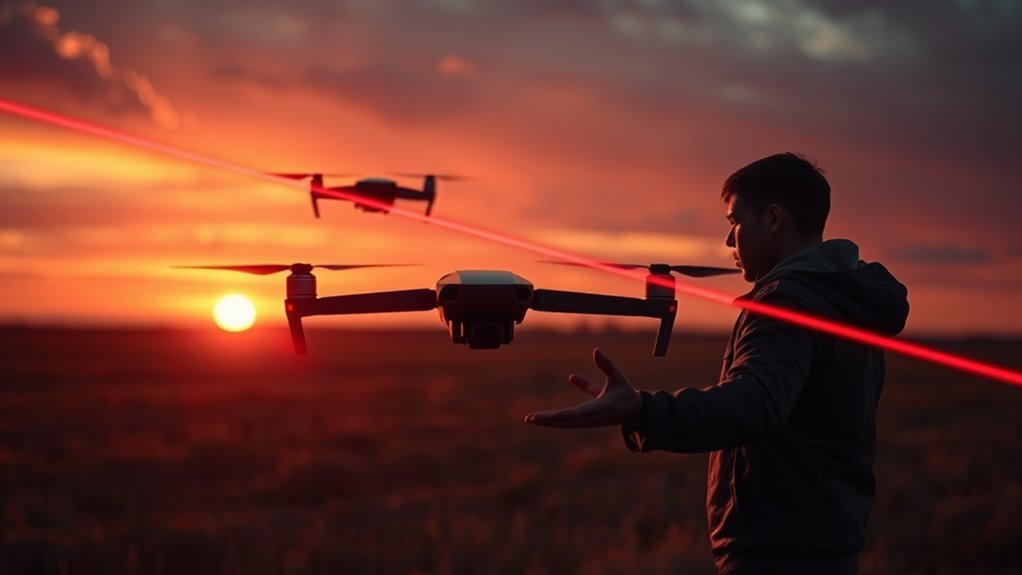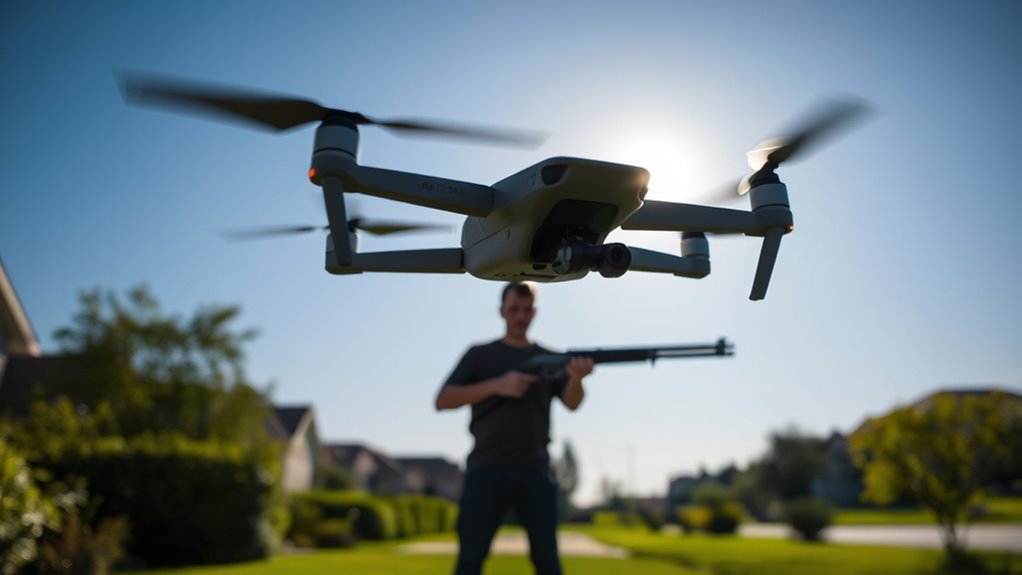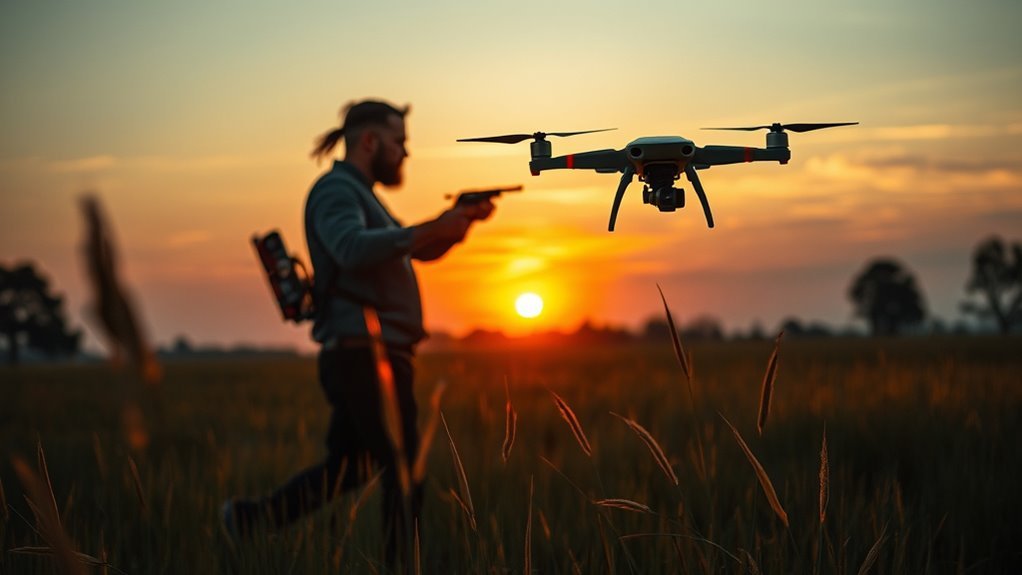You can’t legally shoot down a drone without significant repercussions. Federal regulations classify drones as aircraft, prohibiting the use of force against them. This could lead to fines or criminal charges, and shooting a drone poses risks to bystanders. Additionally, state regulations vary; some allow reasonable force, while others strictly forbid it. Understanding these regulations is essential before taking any action. Learn about alternatives and legal implications to better protect your interests.
Understanding Drone Regulations

When considering whether you can shoot down a drone, it’s vital to understand the regulations governing unmanned aerial vehicles (UAVs). Drone safety is paramount, and regulatory compliance is mandatory to guarantee the protection of airspace and individuals. The Federal Aviation Administration (FAA) strictly prohibits the use of force against drones, viewing them as aircraft. By shooting down a drone, you risk legal repercussions, including fines or criminal charges. Furthermore, you could endanger innocent bystanders and create safety hazards. It’s important to familiarize yourself with local laws and FAA guidelines regarding UAVs. Always prioritize peaceful resolution methods, such as contacting authorities, to address any concerns about drone activity. Maintaining safety and compliance keeps everyone protected while enjoying technological advancements. Additionally, understanding FARs’ altitude restrictions ensures that drone operators respect property rights and operate within legal parameters. Compliance with NDAA regulations not only safeguards national security but also reinforces the importance of lawful drone operations.
The Legal Implications of Shooting Down a Drone

What happens legally if you decide to shoot down a drone? In most jurisdictions, you could face serious legal repercussions. Shooting down a drone may violate airspace sovereignty laws, as drones operate within regulated airspace, similar to manned aircraft. Engaging in such actions could be viewed as an act of drone warfare, potentially leading to criminal charges or civil liability for damages. The law generally does not permit the use of force against an aircraft unless in defense of imminent threats, which complicates your justification. Furthermore, federal laws often supersede state regulations, making it critical to understand the legal framework governing aerial devices. Consider the implications carefully before taking matters into your own hands.
Privacy Concerns and Personal Property Rights

As drones increasingly invade personal spaces, concerns about privacy and property rights become paramount. You may question whether the presence of a drone over your property constitutes an unlawful intrusion. Additionally, the legal ownership of airspace complicates the issue, raising critical questions about your rights in response to perceived invasions.
Personal Space Invasion
The rise of drones in civilian airspace has sparked significant debate over personal space invasion, particularly regarding privacy concerns and property rights. You might feel your personal boundaries are threatened as drones can inadvertently or intentionally intrude into your space. Invasion fears are valid; the ability to capture images or data without consent challenges the very essence of your privacy. As drones become more prevalent, understanding their impact on personal property rights is vital. It’s important to reflect on how surveillance and data collection via drones could infringe on your autonomy. Balancing technological advancement and individual freedom requires vigilance and awareness. Ultimately, protecting your privacy in this evolving landscape hinges on establishing firm boundaries against these aerial intrusions.
Legal Ownership Issues
While drones offer innovative capabilities, they also raise complex legal ownership issues that intertwine with privacy concerns and personal property rights. You might find yourself questioning the implications of drone ownership, especially when it comes to your right to control your environment. If a drone invades your space, the liability issues can become convoluted. Are you justified in taking action against an infringing drone, or are you infringing on someone else’s property rights? The legal landscape is still evolving, and understanding your rights is vital. Without clear regulations, the balance between personal freedom and the rights of drone operators remains precarious. It’s essential to navigate these issues carefully to guarantee that your freedoms are protected while respecting others’ rights.
State-Specific Laws on Drone Interception
Understanding state-specific laws on drone interception is essential for traversing the legal landscape. Each state has its own regulations that dictate the circumstances under which you could legally intercept a drone, along with associated enforcement mechanisms and penalties. Familiarizing yourself with these variations can help you avoid potential legal repercussions. Additionally, awareness of local regulations is crucial to ensure you are compliant with laws governing drone operations in your area.
Legal Framework Overview
As you navigate the complex legal terrain surrounding drone interception, it is crucial to recognize that state-specific laws vary considerably across the United States. These laws often focus on drone ownership rights and the circumstances under which you might legally intercept a drone. Some states explicitly permit the use of reasonable force, while others impose strict prohibitions, complicating matters for individuals seeking to protect their privacy. Liability issues arise when evaluating whether you could face criminal charges or civil lawsuits for damaging a drone. Understanding these nuances is critical, as your actions may have unintended consequences. Always consult local regulations to guarantee you’re fully informed about your rights and responsibilities before considering any interception actions.
State-Specific Regulations
Given the rapid evolution of drone technology, state-specific regulations regarding interception can be quite varied and intricate. Each state has its own laws governing drone ownership and the potential to intercept unauthorized UAVs. For instance, some states allow individuals to protect their property from drones, while others strictly prohibit any form of interception, often citing safety and privacy concerns. State enforcement agencies may take different approaches, with some prioritizing drone regulation compliance and others focusing on personal freedom in protecting one’s space. It’s essential for drone owners and concerned citizens to familiarize themselves with local laws to navigate these complex regulations effectively, ensuring they don’t inadvertently run afoul of state mandates while seeking to assert their rights.
Enforcement and Penalties
State-specific laws on drone interception not only vary regarding what actions are permissible but also in how they enforce these regulations and the penalties for violations. Enforcement strategies can include local law enforcement agencies or specialized drone task forces, depending on the state. Some states may adopt a proactive approach, while others might focus on reactive measures, leading to inconsistencies.
Penalty frameworks also differ markedly; fines can range from minor civil penalties to severe criminal charges, reflecting the seriousness of the infraction. In certain jurisdictions, you might face hefty fines or even imprisonment for unlawful drone interceptions. Understanding these variations is essential for anyone considering taking action against a drone, as ignorance of local laws can lead to unintended legal consequences.
The Technology Behind Drone Detection and Neutralization
While the proliferation of drones has heightened concerns about security and privacy, advancements in drone detection and neutralization technology have emerged to address these challenges. You’ll find that various methods exist for drone detection, including radar systems, radio frequency (RF) scanners, and electro-optical sensors. These technologies help identify unauthorized drones in real-time, enabling swift responses. Once detected, neutralization technology comes into play, employing techniques like jamming, net capture systems, or even directed energy weapons to disable or remove drones safely. By utilizing these sophisticated tools, individuals and organizations can enhance their security measures, ensuring a balance between personal freedom and protection against potential drone-related threats. This technological evolution is essential in maintaining autonomy in increasingly crowded airspace. Furthermore, integrating detection technologies with alert systems can further enhance situational awareness and response capabilities. Asylon Drone’s advanced machine learning algorithms aid in improving the efficiency of drone detection and response systems.
Potential Consequences of Shooting a Drone
Shooting down a drone may seem like a straightforward solution to immediate threats, but it carries significant legal and safety implications. You need to evaluate the potential consequences:
- Legal repercussions: Shooting a drone could lead to criminal charges or civil lawsuits.
- Drone safety concerns: Disabling a drone mid-air could cause it to crash unpredictably, risking lives.
- Property damage: A downed drone can result in damage to nearby structures or vehicles.
- Escalation of conflict: Engaging with a drone might provoke further hostility from its operator.
- Liability issues: If you cause injuries or damages, you might be held financially responsible.
Understanding these factors is essential before deciding to take aggressive action against a drone.
Alternatives to Shooting Down a Drone
Instead of resorting to destructive measures, there are several effective alternatives for addressing a drone that poses a threat or invades privacy. One option is drone jamming, which disrupts the communication signals between the drone and its operator. This method can render the drone inoperable without causing physical damage. Another alternative is net capture, where specialized nets are deployed to physically ensnare the drone, safely bringing it down without collateral damage. These techniques not only help maintain your privacy and safety but also align with a broader respect for individual rights and freedoms. By utilizing non-destructive methods, you can effectively neutralize a drone threat while preserving the integrity of the surrounding environment. Additionally, employing proactive vulnerability identification can further enhance security measures against potential drone threats. Understanding the limitations of drone technology, such as signal attenuation, is also crucial in developing effective countermeasures.
Law Enforcement and Drone Interception
As drone technology becomes increasingly prevalent, law enforcement agencies are faced with the challenge of effectively intercepting unauthorized or dangerous drones. To navigate this complex landscape, law enforcement protocols must incorporate a variety of drone interception techniques, ensuring public safety while respecting individual freedoms.
Here are some key interception methods:
- Signal Jamming: Disrupting communication between the drone and its operator.
- Net Capture: Using nets to physically ensnare drones mid-flight.
- Hacking: Gaining control over the drone’s navigation system.
- Drone Swarms: Deploying multiple drones to intercept and neutralize threats.
- Laser Systems: Utilizing directed energy to disable drones.
These techniques highlight the need for precise, adaptable strategies in the rapidly evolving world of drone technology.
Case Studies of Drone Incidents
As you examine various drone incidents, it’s essential to contemplate the legal implications of engaging such aerial threats. Notable cases of drone shootdowns highlight the complexities of using force in civilian airspace and the evolving defense technologies employed. Analyzing these scenarios will provide valuable insights into the operational and regulatory challenges surrounding drone interception.
Legal Implications of Engagement
While the use of drones has become increasingly prevalent in various sectors, the legal implications of engaging or shooting down a drone can be complex and multifaceted. Understanding these implications requires careful consideration of factors like:
- Drone trespassing: Is the drone invading your airspace?
- Aerial surveillance: Is it gathering data on private property?
- State laws: What do local regulations say about drone engagement?
- Self-defense: Can you claim a threat from the drone?
- Liability: Who’s responsible for damage caused by shooting it down?
You might feel tempted to act, but the consequences could lead to legal trouble. Always assess the situation and know your rights before taking action against a drone.
Notable Drone Shootdowns
Engaging a drone can lead to serious legal ramifications, and understanding real-world cases can shed light on the complexities involved. For instance, during military operations, the downing of enemy drones has often been justified under the laws of armed conflict. However, the unintended consequences can be severe, with collateral damage to civilian life or property. Conversely, shootdowns aimed at drones infringing on wildlife protection areas have raised ethical questions about human intervention versus ecological balance. In one notable case, a drone was shot down while surveilling a protected habitat, igniting debate on whether the action was warranted to safeguard endangered species. These examples illustrate the delicate balance between national security, wildlife protection, and individual rights in drone engagement scenarios.
Defense Technologies in Action
When evaluating the effectiveness of defense technologies in real-world drone incidents, it’s essential to examine specific case studies that highlight both successes and failures. These examples reveal how drone defense systems are applied in military contexts:
- Successful interception of hostile drones using electronic warfare techniques
- Integration of anti-drone systems in urban settings to protect civilian areas
- Failures in engagement due to misidentification of friendly drones
- Deployment of laser systems demonstrating precision target elimination
- Usage of counter-drone technology in high-stakes military operations
Understanding these incidents not only showcases the advancements in drone defense but also emphasizes the need for ongoing development to guarantee freedom from aerial threats. Each case study provides valuable insights into the complexities of modern military applications in drone defense.
Future of Drone Legislation and Personal Rights
As drone technology continues to evolve, the legislative framework governing its use must adapt to balance personal rights with safety and privacy concerns. You might find that current laws often lag behind advancements, particularly as drone warfare escalates in complexity. Your personal autonomy is at stake, especially when it comes to the use of drones for surveillance or military operations. Future legislation must guarantee that your rights aren’t infringed upon while providing clear guidelines for lawful drone use. This balance is vital to prevent misuse that could infringe on your freedoms. Advocating for transparent regulations can empower you to maintain control over your personal space without sacrificing safety, fostering a drone landscape that respects both innovation and individual liberties. The evolving capabilities of drones, such as advanced battery technology, will further necessitate ongoing discussions about their regulation and the implications for personal rights. Additionally, the potential impact of supply chain disruptions on drone availability could influence legislative priorities as the industry adapts to changing market dynamics.
Frequently Asked Questions
Can I Use a Drone to Intercept Another Drone?
You can use a drone for interception, employing drone interception tactics and aerial combat strategies. However, make sure you understand regulations and potential risks, as unauthorized actions could lead to legal consequences or safety hazards.
What Types of Drones Are Most Vulnerable to Being Shot Down?
Picture a toy drone, fragile and lightweight, easily taken down. Military drones, armored yet complex, resist damage. Commercial drones balance durability with vulnerability, while racing drones, fast but delicate, can also fall prey to skilled interception.
How Can I Protect My Property From Drone Surveillance?
To protect your property from drone surveillance, consider employing drone detection systems. Familiarize yourself with privacy laws in your area, ensuring your rights are upheld while maintaining your freedom from intrusive aerial observation.
Are There Non-Lethal Methods to Disable a Drone?
If you’re looking to gently steer a drone off course, consider jamming its signals or employing net capture techniques. These non-lethal methods can effectively neutralize unwanted aerial watchers while preserving your rights and tranquility.
What Should I Do if a Drone Is Hovering Over My Property?
If a drone’s hovering over your property, document its presence and consider contacting local authorities. You should be aware of drone privacy laws and potential legal consequences before taking any action to guarantee your rights are protected.

